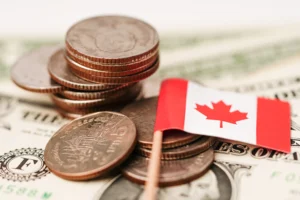The Canada economic collapse is not a prediction but a reality that is already unfolding. One of the world’s most developed economies is currently experiencing slow growth, massive debt, and a weakening currency. With debt levels above 100 percent of GDP, a housing market in decline, and a currency losing global confidence, Canada is facing an economic challenge that is reshaping its financial landscape.
This crisis stands in sharp contrast to what is happening in Saudi Arabia. A nation once viewed as oil-dependent is now outperforming several Western economies. The Canada vs. Saudi Arabia economy comparison tells a story of two resource-rich countries moving in opposite directions. Saudi Arabia has embraced reform, while Canada remains burdened by inefficiency and regulatory complexity.
This article explains why the Canada economic collapse is happening, how debt and currency weakness are connected, and what lessons traders can learn from Saudi Arabia’s transformation. It focuses on data, not politics, and highlights what investors and citizens should prepare for in the years ahead.
Canada vs. Saudi Arabia: Diverging Economic Paths
Both nations share similar population sizes and abundant natural resources. However, their recent economic trajectories are drastically different. Saudi Arabia’s GDP growth in 2025 is estimated at 4.5 percent, with non-oil sectors expanding at over 6 percent. Canada, on the other hand, has recorded less than one percent growth, with the second quarter of 2025 showing a GDP contraction of 1.6 percent.
Saudi Arabia’s progress comes through strategic planning. Through its Vision 2030 program, the country is moving away from oil dependency and developing sectors such as renewable energy, finance, tourism, and logistics. Canada, despite its resource diversity, continues to rely on oil sands, housing, and government spending for growth.
In 2025, Saudi Arabia attracted more than 15 percent additional foreign direct investment compared to the previous year. Canada, in contrast, saw a decline of almost 7 percent. Businesses view Saudi Arabia as a quick, transparent environment, while Canada’s red tape discourages entrepreneurs and global investors.
This difference is not about luck. It is about direction and policy. Saudi Arabia encourages innovation through efficiency and clarity, while Canada slows progress through regulation and bureaucracy. These choices determine why one economy is expanding and the other is contracting.
Debt and Fiscal Burden: Why Canada’s Numbers No Longer Add Up
At the center of the Canada economic collapse is the rising weight of national debt. According to the International Monetary Fund, Canada’s total public debt now exceeds 2.3 trillion Canadian dollars. The Canada debt-to-GDP ratio stands at over 106 percent, making it one of the highest among developed nations.
Saudi Arabia’s debt level remains near 30 percent of GDP, a figure that reflects fiscal discipline and careful spending. The contrast shows how two nations with similar revenue potential have handled their finances differently.
Debt in itself is not necessarily harmful. The issue is how it is used. In Saudi Arabia, debt supports infrastructure, clean energy projects, and innovation. In Canada, much of it funds consumption and government operations. The result is stagnation rather than progress.
On average, each Canadian carries over 55,000 CAD in national debt. This figure is greater than the median income. By comparison, the per-person debt in Saudi Arabia is around 10,000 USD. The difference in fiscal management directly impacts economic confidence and currency performance.
As interest rates rise, Canada spends billions annually on debt servicing. It is anticipated that the federal interest bill will exceed 50 billion Canadian dollars in 2025. We could have invested that amount in innovation, small business support, or renewable energy programs. The long-term outcome of poor fiscal choices is slower growth and weaker purchasing power, accelerating the Canada economic collapse.
The Canadian Dollar Collapse
The Canadian dollar collapse is the clearest symptom of an economy losing investor trust. The CAD has fallen nearly 20 percent since 2021 and now trades near 1.40 per USD. Analysts warn that if debt and trade imbalances continue, the rate could reach 2.00 per USD within a few years.
The price of gold in Canadian dollars confirms this trend. In 2020, gold traded at around 1,500 CAD per ounce. It has surpassed 7,000 CAD in 2025. This figure does not simply mean that gold became more valuable; it shows that the Canadian dollar has lost purchasing power.
Several factors drive this weakness:
- Excessive government borrowing reduces investor confidence.
- Weak productivity lowers export competitiveness.
- Heavy dependence on U.S. trade limits monetary flexibility.
Saudi Arabia’s currency remains stable because it is supported by strong reserves and disciplined fiscal management. Investors view the riyal as stable, while the CAD appears exposed and vulnerable. This growing divergence reflects structural health, not short-term volatility.
For traders, this environment presents opportunity. Those who understand the long-term macro imbalance between Canada and other nations can position strategically for gains as the Canadian dollar collapse deepens.
The Canada Housing Market Crisis: A Warning to the Middle Class
The Canada housing market crisis sits at the heart of the current economic downturn. Property values have declined by nearly 30 percent in major cities, yet homes remain unaffordable. Even young professionals with significant savings cannot buy modest apartments due to high interest rates and tight lending conditions.
Real estate has long been the backbone of Canada’s economy. It represents over 60 percent of household wealth and drives a major share of national GDP. The correction now underway is more than a property issue. It is an economic rebalancing that affects banks, consumer spending, and long-term financial stability.
In Saudi Arabia, housing policy has taken a different route. The government provides new families with up to 150,000 USD in grants for first-time home purchases. These incentives boost ownership and stimulate domestic demand.
In Canada, by contrast, speculation replaced strategy. Years of cheap credit inflated property prices beyond reason. When the Bank of Canada raised rates to control inflation, the bubble deflated, leaving many households trapped in debt and negative equity. This structural weakness amplifies the Canada economic collapse and deepens inequality between generations.
Public Systems in Decline: Healthcare and Education Struggling to Cope
The Canada that once prided itself on universal healthcare and quality education now faces visible strain. Hospitals report long waiting times, underfunding, and staff shortages. Doctors and nurses increasingly migrate to the United States for better pay. Schools are also feeling the impact, with budget cuts, outdated technology, and rising tuition fees.
Saudi Arabia, by contrast, continues to strengthen public systems. Vision 2030 includes large investments in healthcare modernization, digital patient management, and global university partnerships. The kingdom’s goal is not only access but also quality. This focus has improved both productivity and satisfaction among citizens.
The Canada vs. Saudi Arabia economy comparison is most revealing here. Canada’s government spends heavily but inefficiently. Bureaucracy absorbs resources that should improve outcomes. Saudi Arabia spends strategically, focusing on long-term returns through infrastructure and education. This difference defines the future trajectory of both nations.
Red Tape and the Innovation Blockade
The private sector in Canada suffers from a system that discourages growth. Starting a business can take months due to zoning rules, environmental clearances, and excessive documentation. Many entrepreneurs give up or move operations abroad, where processes are simpler.
Saudi Arabia has adopted an entirely different approach. Saudi Arabia established a digital one-stop registration platform that enables the acquisition of a business license in less than a day. This policy shift has fueled a 15 percent rise in foreign investment within a year.
Canada’s excessive red tape is more than an inconvenience; it is an economic brake. When outdated regulations trap creativity, innovation cannot flourish. Reducing these barriers would immediately encourage job creation, tax revenue, and technological advancement.
Without serious reform, the Canada economic collapse will worsen as investors and skilled workers continue to seek better opportunities elsewhere.
Lessons from Saudi Arabia’s Transformation
Saudi Arabia’s economic transformation offers critical lessons. The country used oil wealth to build a foundation for diversification. Through projects like NEOM and the Red Sea Development, it invests in technology, tourism, and sustainable energy. These industries are now major contributors to GDP and employment.
Canada could follow a similar model by channeling its resources into innovation and manufacturing. However, political indecision and over-regulation continue to slow progress. The focus on short-term popularity instead of long-term strategy prevents real transformation.
The Canada vs. Saudi Arabia economy comparison proves that leadership and planning matter more than natural wealth. Saudi Arabia’s ability to adapt has given it a competitive edge in the global economy. Canada must rediscover this adaptability to restore stability and confidence.
Global Outlook: Western Currencies and the Macro Cycle
The Canadian dollar collapse is part of a broader pattern. Several Western currencies, including the British pound and Australian dollar, are weakening due to similar fiscal and structural challenges. Global investors are shifting their focus toward economies that demonstrate discipline and growth potential.
Countries such as Saudi Arabia, Singapore, and the UAE have become preferred destinations for capital. They offer low debt, strong fiscal control, and clear policy direction. In contrast, Canada, the United Kingdom, and Australia face slow growth, high debt, and political stagnation.
For traders, this is an opportunity to position for long-term gains. Currency cycles tend to last years. A well-timed short on CAD or GBP can yield thousands of pips over time. Investing in gold, commodities, or stable emerging market currencies can also protect wealth as Western currencies weaken.
Building Generational Wealth in an Era of Economic Change
Periods of crisis often create lasting opportunities. The Canada economic collapse presents one of those rare turning points where long-term thinkers can build wealth through strategy rather than speculation.
Smart investors and traders can take several practical steps:
- Monitor macroeconomic indicators like debt ratios and trade balances.
- Diversify portfolios with assets tied to stable currencies and commodities.
- Hold positions that align with long-term structural trends.
- Avoid emotional trading and focus on data-driven analysis.
The currency markets reward patience and conviction. A CAD/USD move from 1.40 to 2.00 would represent nearly 6,000 pips of potential gain. Similar opportunities may arise in GBP and AUD pairs as fiscal imbalances widen.
The lesson is clear. Those who study macro shifts and act early stand to benefit the most when cycles turn.
Can Canada Recover?
Recovery is still possible, but it requires courage and reform. Canada must simplify regulations, control spending, and promote innovation. A national productivity agenda that focuses on technology, renewable energy, and skilled immigration could reignite growth.
The government must also address the Canada Housing Market Crisis by improving supply, cutting speculative demand, and supporting first-time buyers. Rebuilding investor confidence in the Canadian dollar collapse will depend on demonstrating fiscal responsibility and long-term vision.
If Canada embraces reform, it can reverse decline. If it continues on its current path, the gap between Canada and nations like Saudi Arabia will only widen.
Final Thoughts
The Canada economic collapse reflects a deeper truth about global economics. Prosperity does not depend on history or reputation. It depends on adaptability, efficiency, and vision. Saudi Arabia’s rise proves that even nations once considered dependent can surpass established powers through planning and discipline.
Canada still has immense potential. It possesses natural wealth, a skilled population, and a strong democratic system. What it lacks is urgency and focus. Until those are restored, the symptoms of decline—debt, inflation, and currency weakness—will continue to define its economy.
For traders and investors, this period marks both a warning and an opportunity. Those who understand macro trends and prepare for the shifts ahead will be positioned not just to survive but to thrive.
Read here to learn more about “Top 10 CFD Trading Strategies for Beginners and Experts in 2025“

I’m Chaitali Sethi — a seasoned financial writer and strategist specializing in Forex trading, market behavior, and trader psychology. With a deep understanding of global markets and economic trends, I simplify complex financial concepts into clear, actionable insights that empower traders at every level. Whether it’s dissecting winning strategies, breaking down market sentiment, or helping traders build the right mindset, my content bridges the gap between information and implementation.




